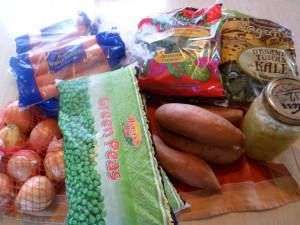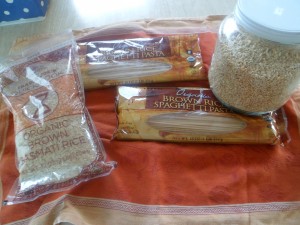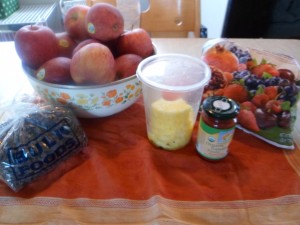SNAP Challenge (aka Food Stamp Challenge) Week
Posted by doctoracorinna on Apr 21, 2013 in Frugal Living | 3 commentsMy family is undertaking the SNAP Challenge this week. The rules for the particular challenge we are doing are as follow:
1) Each person should spend a set amount for food and beverages during the Challenge week. That amount is:
| Household size | 1 | 2 | 3 | 4 | 5 | 6 | 7 | 8 |
| Food Stamp Challenge Daily Budget |
$7 | $12 | $18 | $22 | $26 | $32 | $35 | $45 |
* Note that the daily budget amount per person goes down as the number of people in the household increases.
This per person amount is based upon SNAP benefits given in the state of Washington currently.
2) All food purchased and eaten during the Challenge week, including fast food and dining out, must be included in the total spending.
3) During the Challenge, only eat food that you purchase for the project. Do not eat food that you already own (this does NOT include spices and condiments.)
4) Avoid accepting free food from friends, family, or at work, including at receptions, briefings, or other events where food is served. *I have chosen to bend the rules on this one, as we will be attending a potluck and also bringing food to another event: since we are contributing to the food being eaten I feel that this is an acceptable change to the rules for our family. Make your own judgement calls on this.
5) Keep track of receipts on food spending and take note of your experiences throughout the week.
6) Invite others to join you, including co-workers, reporters, chefs, or other elected officials.
If you have been following along on my facebook page you will know I have been doing a large amount of research to create a healthy, filling meal plan that fits into this budget. One of the things that has really helped me is the fact that originally the budget was supposed to be less than $90 for the week, but after looking at the amount of money allocated through the Washington SNAP system the challenge makers decided to increase the budget. That additional $36 is making this challenge more do-able.

The vegetables we will be eating during the SNAP Challenge. Clockwise from upper left: 5 pounds organic carrots, 1 bag rainbow chard, 1 bag organic kale, homemade live culture sauerkraut, 3 pounds sweet potatoes, 6 pounds green peas, 1.5 pounds onions.
One of the things that I have already learned from preparing for this challenge is the fact that there are calls for reducing food stamp funds with the governmental sequester. Now that I have seen just how incredibly hard it is to create a filling, healthy meal plan from the money allocated I am very concerned about this push and will be letting my representatives know that I support food assistance for those who need it.
So what did our grocery list look like for this coming week?
Food budget:
Organic Apples: $1/pound (sale). QFC We got 10 pounds.
Organic White Beans (dry): $1.29/pound Town and Country Markets. We got 2 pounds.
Organic Berries/pound (frozen): $3.33 Costco (this has to be bought in 3 pound bulk bags that cost $9.99 each). We will eat 1 pound of berries this week.
Organic Brown Rice/ 2 pounds: $3.99 Trader Joe’s

The whole grains we will be eating during the SNAP Challenge: Steel cut oats, brown rice, brown rice noodles
Kerrygold Butter (this is a really good butter as it is from grassfed cows, grassfed/pastured cows milk is always healthier and less inflammatory than grain fed cows milk)/half pound: $2.33 Costco (this was bought in bulk with two other half pound sticks of butter: total cost for 3 is $6.99) We will only be eating 1/2 pound of butter this week.
Green Cabbage/pound: 0.89 cents at QFC. I bought two pounds ($1.61) to make live culture sauerkraut. I started the sauerkraut a week ago so it would be ready to go for the challenge. Cabbage is okay non-organic because of the way it is grown.
Organic Carrots/pound: 0.79 cents Trader Joe’s. We got five pounds at $3.95 total. We like organic carrots best because of the flavor. Please note: carrots are not actually a source of Vitamin A, they contain carotenoids, which can be converted to Vitamin A if you have the necessary precursors.
Chard/bunch: 2 bunches at 4.49 total. Trader Joe’s (1.99) and the Ballard Farmer’s Market ($2.50).
Free Range Chicken (whole)/pound: $1.99 Trader Joe’s. 5 pounds at $10.01 total. The fact that the chicken is whole is important, as it means we get bones to make chicken broth from. We will be cooking our beans and rice in this broth to increase the nutrient density of our meals.

The protein we will be eating during the SNAP Challenge. Clockwise from upper left: organic white beans, raw grassfed milk, organic whole fat yogurt, free range whole chicken, grass fed beef liver, grass fed ground beef, pastured chicken eggs, grass fed butter.
Pastured Eggs: $5.35 for a dozen. PCC Markets.
Green Peas (frozen): $5.63 for 6 pounds. Grocery Outlet. Since peas are on the ‘clean 15’ list these were bought non-organic.
Grassfed Beef Liver/pound: $3.69. PCC Markets. We will use this to stretch out our ground beef and to increase the nutrition profile. Please be sure you are getting liver from a grassfed cow for the most nutritious and cleanest source.
Grassfed Ground Beef/pound: $4.99 at Trader Joe’s. 2 Pounds total at $9.98 (Sale)
Organic Honey: 1/2 pound $2.50. Town and Country Market. Organic/local honey is best as it ensures the honey is pure. Local honey has been helpful (for some people) to deal with seasonal allergies.
Organic Kale/bunch: 3 bunches from Trader Joe’s ($2.29 for a bag) and farmer’s market ($2.50 each): $7.29 total. You want to get kale organic because of the way it is grown.
Organic, raw milk: 1 gallon: $10. We choose to get our milk from a reputable dairy that is very, very diligent about the health and well being of their cows. Raw milk is not sold in most grocery stores in Washington due to concerns of disease that may be in the milk. Raw milk has enzymes and other nutrients that make it more healthful for those who choose to drink milk. This is not an endorsement for raw milk, simply the choice our family has made for our own health.
Onions: .98 cents/pound. Town and Country Markets. Not necessary to buy this organic because of the way it is grown. $1.47 for 1.5 pounds.
Pineapple: $2 for one cored pineapple QFC (sale)
Organic, Fair Trade Quinoa: $1.75 for one half pound at Town and Country Markets. This is a great source of complete protein and tastes delicious.
Organic Raisins: $2.49 a pound. Town and Country Markets. (On sale) Always buy raisins organic because of the way it is grown.
Organic Raspberry Fruit Sweetened Jam: $2.99 per 10 oz bottle. Trader Joe’s. We sweeten our daughter’s plain whole milk yogurt with this, so we can be in charge of how much sugar she is ingesting. Always eat berries organically because of the way they are grown.
Brown Rice spaghetti noodles: $1.99 per pound. We got 2 pounds because we are making a dish to serve at a homeless shelter one day this week. Trader Joe’s.
Organic Spaghetti Sauce: $1.50 for a bottle. Albertsons. (On sale and with a coupon.)
Organic Steel Cut Oats: .99 cents/pound: $2.50 for 2.5 pounds. Town and Country Markets. (On sale.)
Sweet Potatoes: .33 cents/pound. $1.05 for a little more than 3 pounds. Albertsons. (On sale) Sweet potatoes are one of those foods you can eat non-organically because of the way they are grown. They are not actually a source of vitamin A, but with the proper precursors the body can convert the carotenoids into vitamin A.
Organic Tomato Paste (in a glass jar: always get your tomato products in glass because the acid leeches BPA from the can lining) $2.49. Town and Country Markets.
Organic Whole Plain Yogurt: $2.99 for one quart. Trader Joe’s.
We also had a little room in our budget for a treat out at the zoo and to get a pastry to take to church for the coffee hour. We have .78 cents left of our allotment of $126 for the week. I have tasked my husband to figure out how much it costs him to make coffee at home. I’m pretty sure that .78 will be going toward home brewed coffee.
Total spent thus far: $125.22

The fruit we will be eating on the SNAP Challenge: From upper left: Organic apples, organic frozen berries, organic tomato paste, pineapple, organic raisins. Not pictured: organic raspberry jam.
As you can tell, I did a LOT of comparison shopping and was able to buy our food from several different stores. Because of the commute between my office and our home I was able to stop at almost all of these grocery stores on my way home. One of the really helpful ways to reduce your food budget is to create a price book so you know when a sale is a good deal. You can check ahead on prices by looking at the weekly circulars that come in your mail. That’s how I found out about the $1 organic apples this week.
I will share some of our meals we are making with these foods over the next week. Stay tuned!

Awesome!
You guys are so lucky to have Trader Joes. Here in Missoula we are spending close to double what we spent in Seattle simply because of the lack of Trader Joes! But the tradeoff is the summer farmers markets where we can get a HUGE bag of produce for $25.
So good to see such healthy choices for the SNAP budget. Buying whole chickens is definitely the way to go. I had to Youtube videos on how to cut up a whole chicken at first – now I’m a pro!
Thanks Corinne! The question of how to feed the family low-budget, nutritious, environmentally-conscious meals is really important to me, and I learned so much from this post. For example, I didn’t know that sweet potatoes and peas are safe to buy non-organic, and that quinoa is a source of complete protein. Good for you for doing this challenge (and for making food for a shelter!), and thanks again for sharing your experiences.
Update: we ended up eating less than I had expected, so ended up with a food budget of $112 instead of $126 and we even got to go out for ice cream as a treat during the challenge. I am glad to know eating healthy is possible on this budget, it does take quite a lot of planning and time, though.